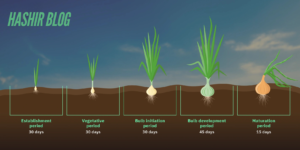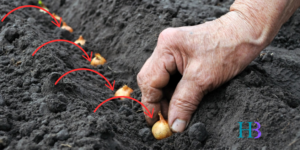Growing Onions: Choosing The Right Type and Harvesting Them
Growing onions is very appealing to commercial farmers because of their many uses in the culinary sector and their high cash crop value. Nevertheless, maintaining high-quality yields is essential to the profitability of onion cultivation and satisfying consumer demand. Finding a field with ideal growth conditions and picking the right cultivar for your region are the first steps in effective production. Furthermore, despite the crop’s common misconception that it is simple to cultivate, proper nutrient and water management are essential. Tools for precision agriculture make it easier to grow onions, guaranteeing effective use of resources and increasing yields.
Onion Types And Varieties To Grow
The creation of the bulb can only be unlocked by variations in day length. Thus, crop varieties are categorized based on how daylighting and bulb initiation relate to one another. Select only cultivars that are appropriate with your growing zone, as day length varies with latitude. Within each category, a wide variety of onions are available for planting:
1-Brief day, When the days are ten or twelve hours long, their bulbs form. Southern regions (25–35 degree latitudes) are ideal for these cultivars’ growth, enabling a harvest to occur before the summer heat waves arrive. Short-day cultivars do not do well in northern climates because they bulb too soon to produce a large enough bulb.
2-Short-day cultivars include Stuttgarter, White Bermuda, Georgia Sweet, Sweet Red, Red Burgundy, White Granex, Hybrid Yellow Granex, and Southern Belle.
3-Day-neutral (intermediate day). When the days get longer—12 to 14 hours—plants in this category start to develop bulbs. The best growing conditions for both short- and long-day onions (32–42 degree latitudes) coincide with those of day-neutral onions. Except for the southernmost states, they thrive throughout the majority of the US. Candy, Sweet Red, Cimarron, Red Stockton, and Super Star are day-neutral types.
4-A long day. These types start bulbs when the days last between 14 and 16 hours. Because of this, the northern regions (37–47 degrees latitudes) are where they yield the highest. White Sweet Spanish, Yellow Sweet Spanish, Walla Walla Sweet, Aisa Craig, Southport Red Globe, Rossa Di Milano, and Norstar are a few of the well-liked long-day cultivars.

Good Growing Conditions for Onions
While they don’t require much heat to flourish, onions will suffer from a lack of sunlight. This plant needs regular watering because its short roots do not have good absorption capacity. We shall discuss these and other particular criteria for onion production in the ensuing sections.
Which Soil Is Ideal For Growing Onions?
Good drainage and a pH range of 6.0 to 7.0 are necessary for onions. Though they may tolerate sandy or clay soils, plants thrive in loamy soils that are rich in organic matter. You will need to water and fertilize the sandy soil more frequently in order to maintain an even moisture level. Add old organic matter to clay and sandy soils to increase their structural integrity.
Onions grow where?
Onions may grow in a number of conditions, including tropical and subtropical ones, despite their preference for temperate temperatures. Grow them in places that are not too hot or too cold, and that don’t get too much precipitation, for best results.
What Are The Sun Requirements And Onion Temperature?
The crop can withstand moderate freezes and other low temperatures because it is fairly hardy. But if a cold spell is expected to bring temperatures down to 20°F (-6°C) or below, cover beds with mulch or cloth. Seedlings will grow much more slowly at air temperatures below 40°F (4°C) and soil temperatures below 55°F (13°C), even though the crop can withstand freezing conditions.
How Much Water Is Needed for Onions?
The amount of water needed by crops varies according to their growth stage, growing environment, and irrigation techniques. Plants require regular moisturizing, roughly 1 inch (25 mm) of water every week, due to their shallow roots. It is especially crucial to supply adequate water during the vegetative stage, before bulb formation begins, in order to attain good yields. More frequent watering is necessary than once a week for newly sprouting plants and those growing in sandy soils.
How to Grow Onions
Given that onions are planted as annuals for their bulbs, they provide some unusual planting resources. They are sown before most other crops because they can withstand cold. Now let’s examine when and how to plant onions to get the best harvest.

Selecting Planting Material for Onions
You can use one of three planting materials to grow the crop:
Seeds. For the least amount of money, this planting material gives the greatest variety of crop types. However, irregular germination is a significant challenge for many farmers when growing crops from seeds. Start your seeds indoors 10 to 12 weeks before you intend to transplant them to promote uniform yields. In colder growing locations, the optimum time to directly sow onion seeds is early spring, shortly after the soil becomes workable; in warmer climates, the best time to plant is late winter or even fall.
Replacements. Usually, seed suppliers sell their transplants—pencil-thick dormant plants—to farmers. Transplants have a greater variety selection, bolt less frequently, and yield more reliably than sets. Wait until the soil temperature reaches 50˚F (10˚C), usually four to six weeks before to the last spring frost, before planting either sets or transplants.
Sets. Another way to plant onions is using sets, which are tiny bulbs that are generated from the seed from the previous growing season. Although sets are simple to cultivate, they are prone to bolting, particularly if the diameter of the set reaches 1 inch (2.5 cm). Sets are more expensive than seeds and offer a considerably restricted number of varieties.
Getting the Soil Ready for Onion Planting

Planting can occur anytime the ground isn’t too wet or too cold. Apply fertilizer to the soil along the selected beds with an NPK ratio of 10-10-10 prior to planting. In order to make it easier for water and nutrients to reach young crops, you should also loosen the soil and add well-rotted organic matter.
How Far Away And How Deep To Plant Onions
It is advised to space onion plants 6 to 10 inches (15 to 25 cm) apart in the ground, and to space rows 2 to 3 feet (0.6 to 0.9 m). Rather, the growing distances in raised beds match the lowest in-ground spacing requirements, which are 1.5 feet (0.6 m) and 6 inches (15 cm), respectively. Greater total yields and a greater number of bulbs result from closer spacing, but smaller individual bulbs.
Choose a planting depth of around one inch (2.5 cm) when choosing how deep to plant onions. When planted too deeply in the soil, plants are unable to bulb properly, which leads to smaller and deformed bulbs. If you want the maximum amount of growth and productivity from your crops
How to Handle Onions
For the crop to flourish, it needs a lot of nitrogen fertilizer and frequent irrigation. Additionally, it is essential to keep a watchful eye out for the appearance of weeds, diseases, and pests and to manage them using a variety of integrated strategies in order to grow onions that are healthy and productive.
| Typical fertilizer requirements for onions | ||
| Nutrient | Amount, lbm/ac | Amount, kg/ha |
| Nitrogen (N) | 54–89 | 60–100 |
| Phosphorus (P) | 22–36 | 25–45 |
| Potassium (K) | 40–71 | 45–80 |
Coordinated Insect, Disease, and Weed Management
Most crop diseases are caused by bacterial and fungal infections, especially in wet growing seasons. If diseases are not treated, they can impede the growth of the bulb and reduce yield. Usually, diseases begin on the leaves. Bulbs may suffer damage from infections later in the onion growing season, which could lead to losses during storage. Early disease detection and reduction of chemical fungicide use are critical for minimizing damage. Food producers can benefit from our crop monitoring solution’s disease risk and scouting features.
How to Collect Onions
The tops of the vines droop and turn yellow as they ripen. Bending down the tops or stamping on them will speed up the last stage of ripening. To prevent the bulbs from decaying while being kept, remove the soil surrounding the plants prior to harvesting and allow them to dry out.
When the bolting plants’ bulbs stop growing, pluck them. These bulbs don’t survive long in storage, so keep them apart and use them right away.



1 thought on “Growing Onions: Sowing, Developing, and Gathering”